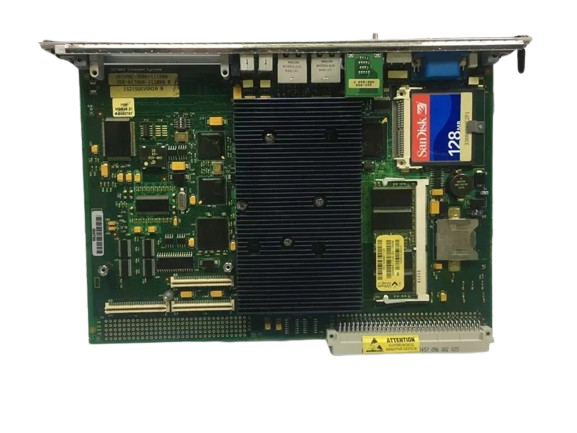
World Of Controls understands the criticality of your requirement and works towards reducing the lead time as much as possible.
IS215UCVGH1AE - VME CPU Controller Single Slot Board is available in stock which ships the same day.
IS215UCVGH1AE - VME CPU Controller Single Slot Board comes in UNUSED as well as REBUILT condition.
To avail our best deals for IS215UCVGH1AE - VME CPU Controller Single Slot Board, contact us and we will get back to you within 24 hours.
SPECIFICATIONS:
Part No: IS215UCVGH1AE
Manufacturer: General Electric
Product Type: VME CPU Controller Single Slot Board
Series: Mark VI
Microprocessor: Intel Ultra Low Voltage Celeron 650 MHz
Memory: 128 MB SDRAM
Operating System: QNX
Primary Ethernet: 10BaseT/100BaseTX
Programming: Boolean
Operating temperature: 0 to 70 �C
Power Supply Voltage: 24 V dc
Board Size: 2.8 cm high x 8.6 cm
Weight: 0.45 kgs
Availability: In Stock
Country of Origin: USA
Manual: GEI-100603A
FUNCTIONAL DESCRIPTION:
IS215UCVGH1AE is a VME CPU Controller Single Slot Board manufactured and designed by General Electric as part of the Mark VI Series used in GE Speedtronic Control Systems. The UCVG is a single-slot board powered by an Intel Ultra Low Voltage Celeron 650 MHz processor, featuring 128 MB of flash memory and 128 MB of SDRAM. It includes two 10BaseT/100BaseTX Ethernet ports (RJ-45 connectors) for network connectivity. The first Ethernet port connects to the UDH for configuration and peer-to-peer communication. The second port operates on a separate IP subnet and supports Modbus or a private EGD network. The configuration of this second port is done via the toolbox, and the controller verifies the toolbox configuration against the hardware during each power-up.
The Innovation Series controller is housed in a family of 6U high, single or double-slot Single Board Computers (SBCs). It is installed on a Versa Modular Euro (VME) rack and communicates with I/O boards via the VME bus. Certain board types also accommodate local I/O through PCI Mezzanine Card (PMC) daughterboards. The controller runs on QNX, a real-time, multitasking operating system built for high-speed, high-reliability industrial use. Application-specific software is loaded using the Control System Toolbox. The controller features three communication ports that connect to the operator and engineering interfaces.
OPERATION:
The controller is loaded with software specific to its application to steam, gas, and land-marine aeroderivative (LM) or balance of plant (BOP) products. It can execute up to 100,000 rungs or blocks per second, assuming a typical collection of average-sized blocks. An external clock interrupt permits the controller to synchronize to the clock on the VCMI communication board to within � 100 microseconds.
External data is transferred to and from the control system database (CSDB) in the controller over the VME bus by the VCMI communication board. In a simplex system, the data consists of the process inputs and outputs from the I/O boards. In a TMR system, the data consists of the voted inputs from the input boards, singular inputs from the simplex boards, computed outputs to be voted by the output hardware, and the internal state values that must be exchanged between the controllers.
INSTALLATION:
A control module contains (at a minimum) the controller and a VCMI. Three rack types can be used, the GE Fanuc integrator�s rack shown in the following figure, and two sizes of Mark VI racks shown in the section, VCMI - Bus Master Controller. The GE Fanuc rack is shorter and is used for stand-alone modules with remote I/O only. The Mark VI racks are longer and can be used for local or remote I/O. Whichever rack is used, a cooling fan is mounted either above or below the controller. The stand-alone control module implemented with a GE Fanuc integrator�s rack also requires a VDSK board to supply fan power and provide the rack identification through an ID plug.
WOC has the largest stock of GE Speedtronic control systems OEM Replacement Parts. We can also repair your faulty boards and supply unused and rebuilt boards backed up with a warranty. Our team of experts is available around the clock to support your OEM needs. Our team of experts at WOC is happy to assist you with any of your automation requirements. For pricing and availability on parts and repairs, kindly contact our team by phone or email.
What is the VME bus standard supported by the CPU Controller Board?
VME CPU Controller Boards typically support the VME64 or VME64x standards, which are enhanced versions of the original VMEbus architecture. VME64 supports 64-bit data transfer, higher data rates, and greater address space, while VME64x includes features for faster data transfers and additional signal pins for more complex systems.
What is the maximum clock speed supported by the VME CPU Controller Board?
The clock speed can vary based on the processor used. Typically, Intel-based VME CPU boards can support clock speeds in the range of 1 GHz to 3 GHz, while PowerPC or ARM-based boards may range from 500 MHz to 1.5 GHz, depending on the processor's architecture.
How much memory can be supported by the VME CPU Controller Board?
The board typically supports dynamic RAM (DRAM), with options ranging from 512 MB to 32 GB or higher. The exact memory size depends on the processor and board configuration. For instance, boards based on Intel processors can support higher RAM capacities than those based on PowerPC.